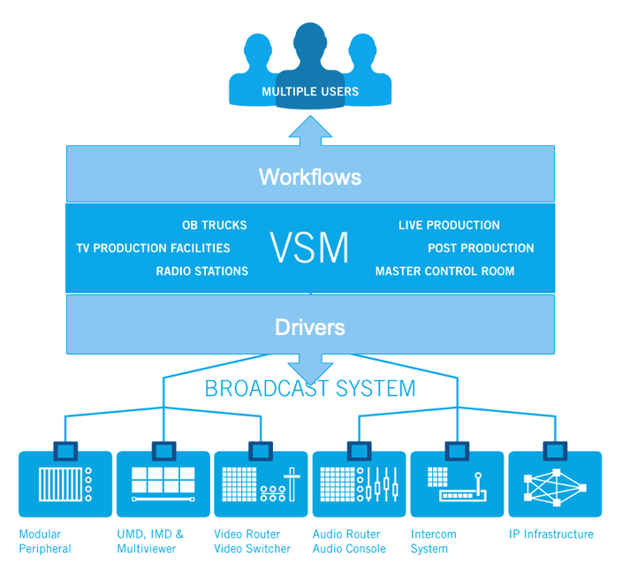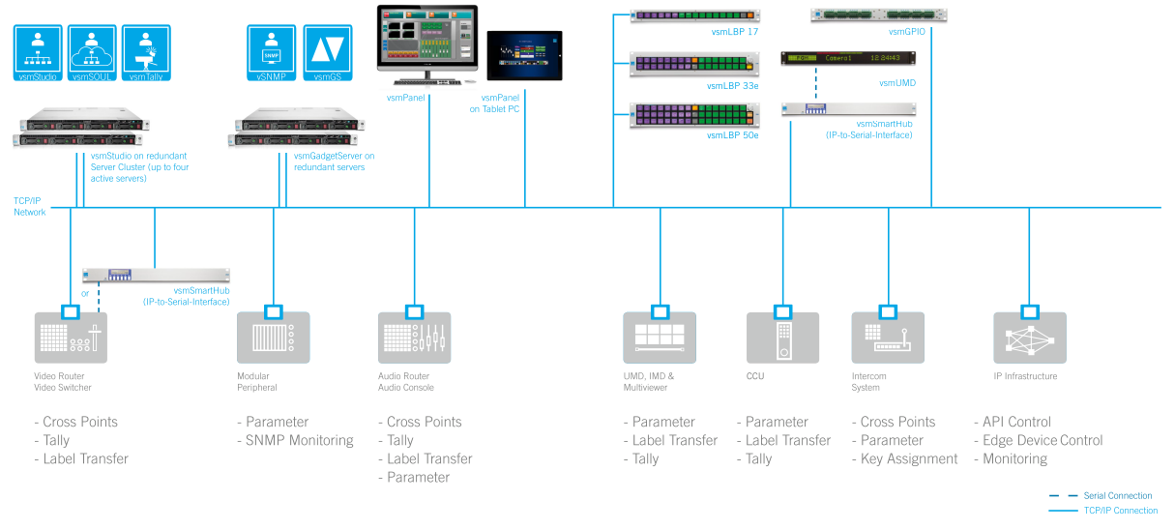VSM - System Overview
VSM – "Virtual Studio Manager"
The basic concept of Lawo's Virtual Studio Manager (VSM) is to control all production devices, their parameters and functionalities from a single, freely-configurable user interface which remains independent of the manufacturer. Thus, components such as a video switcher or router can be interchanged at any time, without impacting upon the end-user operation. During the last few years, this vision has grown into one of today’s most powerful and cost-efficient universal control systems for broadcast applications. Having become the standard for OB-Vans, VSM has also proven itself to be a reliable partner for control functions in radio and TV studios, and master control rooms, around the globe.
The VSM controls routers and their integrated DSP functions, multiviewers, video mixers, audio consoles and modular equipment as well as any third-party devices. Additionally, the VSM control system offers functions, such as Tally, GPI, and Tie-Line Management as well as global labels of connected devices without requiring additional control systems. Most importantly, the VSM offers a unique feature: when running together with the vsmPanel application, the control system provides numerous, freely configurable software front-ends for all users and applications. This makes the Virtual Studio Manager the most flexible control solution to satisfy constantly evolving production demands.

System Architecture
The VSM control system is IP based. This means that the VSM is designed as an “Island Solution” but can also be smoothly integrated into an existing network. The VSM supports anything up to Layer3. Devices to be controlled are connected to the IP backbone, while third party devices are connected to the VSM via TCP/IP or RS-422/RS-232. If the latter only features serial ports, CommServers must be used to translate from RS-422 or RS-232 to TCP/IP. The TCP/IP structure also allows remote access to the system.
The base of the VSM control system consists of one or multiple routers, for increased redundancy. A redundant designed multiserver system can include up to 4 active servers in one cluster. The servers can be based in different locations and provide all data multiple times, thereby providing a redundant system. What makes this VSM server cluster special in comparison to a Master/Backup-design is that different functions are distributed to different servers that all operate concurrently. This load distribution guarantees the highest level of system availability. In the case of one server failing, this server’s functions are smoothly picked up by another server in the cluster. Another advantage of the server cluster is the ability to implement software updates without interrupting the current broadcast.
Generally, all controlled hardware can be integrated into the VSM control system via IP-based serial ports, GPIs, or other standard ports. The VSM supports control protocols for audio, video, time code and control routers of all established manufacturers. The list of supported protocols also includes video mixers, audio consoles, multiviewers, monitors, intercom systems, modular equipment and multiple foreign devices. The VSM also allows the connection to automation systems as well as the control of video servers, audio work stations, CD/DVD players, and clip players. Our developers constantly add new protocols on request of our customers to continuously improve the VSM and to expand its usability. This ensures that the VSM represents a control solution that is constantly up to par and ready for use with cutting-edge technology. The VSM, of course, also controls the internal system hardware, such as “Under Monitor Displays” (UMDs) and “General Purpose Interfaces” (GPIs).
Where the operator is concerned, the VSM system offers hardware and software panels. With the freely configurable LCD button panel-series and the virtual GUI vsmPanel, the entire production environment can be monitored, managed, and controlled. Lastly, the VSM’s flexibility makes the configuration of all workflows quick and easy.

VSM Components
VSM Software Components
These VSM Software Applications are part of a VSM System:
- vsmStudio - is the main administration and configuration tool. It runs continuously on all VSM servers in the system and, as such, forms the heart of the system.
- vsmGadgetServer - is a separate software application that acts as a protocol converter between 3rd party hardware and vsmStudio. This application is used in most VSM installs.
- vSNMP - is an easy-to-use SNMP manager. It provides a central monitoring solution for the complete system. This application is optional, depending on specific workflow requirements.
VSM Control Panels
A combination of hardware button panels and software or web-based control clients can interact with the vsmStudio configuration running on the remote server. Note that, in each case, there is no need for a panel reboot or configuration download. This means that any changes to the design or functionality are instantaneous.
- vsmPanel - a software application that runs on a PC workstation. vsmPanel can be used, in conjunction with vsmStudio, to create virtual panels operated by mouse or touch-screen.
- vsmWebPanel - a software application similar to vsmPanel but with a browser-based (http) graphical user interface. vsmWebPanel can be opened on any desktop PC, laptop, or smartphone with a LAN or WLAN connection to the VSM system.
- vsmLBP Panels - a range of hardware LCD button panels with full multi-color displays.
- vsmENC 17 Panel - a hardware panel with 17 incremental encoders using RGB-backlit displays.
VSM Monitor Displays (UMDs)
A range of Under Monitor Displays (UMDs) can be added to the system to display source and tally information, timers, clocks, etc.
VSM Interfaces
Other optional interfaces include:
- SmartHub - a range of IP-to-Serial (RS422, RS232) interfaces for integrating non-IP devices.
- GPIO Box - a range of GPIO interfaces for General Purpose Interface inputs and outputs.